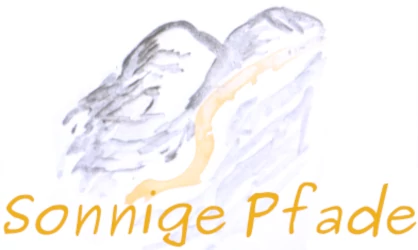
Luxembourg can be reached quickly from the west of Germany, France or Belgium – both the small Grand Duchy as a country and the capital of the same name. And this is what the city trip tip is all about today. Very centrally located in Luxembourg, mountains, valleys and a long and eventful history play a major role for Luxembourg. As Luxembourg also takes on important capital city functions in the EU, such as the seat of the European Court of Justice, the city’s development continues to be very dynamic.
[contains *advertising]
Luxembourg – 3dimensional like no other city!
If you want to experience a city in 3 dimensions, Luxembourg City is the best experience. Because Luxembourg is spread over mountain peaks with narrow river valleys in between – which is quite a challenge for orientation. At least if you are not used to it. For me, who usually gets a rough overview relatively quickly, this meaning of the third dimension was noticeably unusual. If you normally look at a city map, then with some experience or in comparison with the already known routes you can roughly say how fast you are going, where you are going etc. In Luxembourg it can happen that between 300m as the crow flies there is a steep valley in between and you have to descend and ascend on serpentine roads. So at the end you will quickly reach 1500m from the actually only 300m.

Exploring the city of Luxembourg on all levels – with diversity
But this should not deter you – it increases exactly the attraction of this city immensely. As you descend or ascend, the character of the district changes rapidly – upstairs busy shopping, only 50m down suddenly narrow historic alleys, riverside houses, bridges and cosy corners with stylish pubs.
Elevators and cable cars help cobblestone-tired city runners
And you don’t have to walk every ascent – sometimes hidden, sometimes clearly integrated into the architecture, lifts are available that significantly reduce the daily metres of altitude to be covered. For example, to the „Grund„, one of the most beautiful districts of Luxembourg in the valley of the Alzette river – up through the fortress walls and some rocky plateaus, an elevator is available at the Palace of Justice. Or else, you can take the bus. Since March 2020, all local transport in the whole Principality of Luxembourg is free of charge (2nd class, first class on the train costs 6€ as a day ticket). So just get on the train and go. When you’re tired of the pavement, you can get on a bus or the new ultra-modern tram, some of which are still under construction, and go on your city tour.
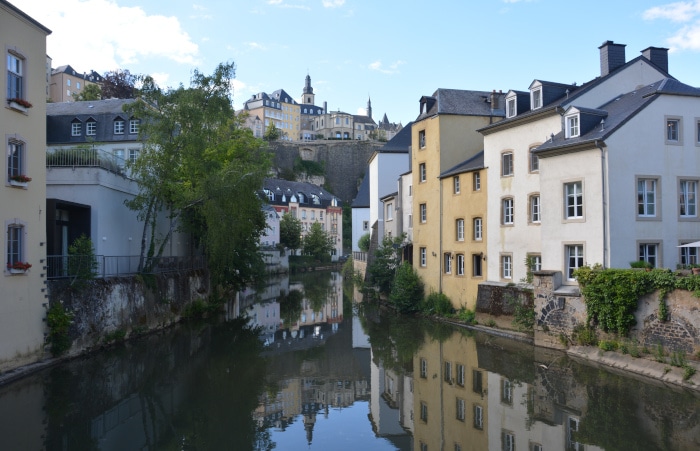
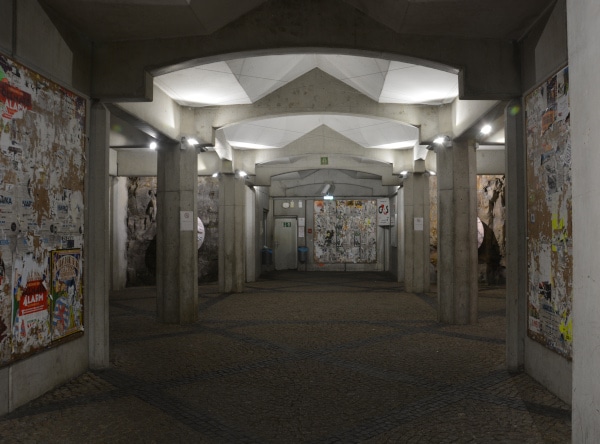
Pfaffenthal – Kirchberg – Music and Art in the Philharmonic Hall and Mudam
An equally modern connection is the Pfaffenthal – Kirchberg railway station. I find it funny from the name or the combination of the districts – below is the valley of the Priests, while the church stands on the mountain. O.k., today up there is mainly the Luxembourg seat of the European Union, the European Court of Justice and in addition the Philharmonic Hall and the „Mudam“, Musée d’Art Moderne Grand-Duc Jean (Luxembourg museum of modern art).
Between the valley and the mountain, halfway up, there is the aforementioned railway station. From there, the train goes to the north of Luxembourg, up to Troisvirges and with connection to the Belgian railway network. The lift takes you down to Pfaffenthal with its little river, hospital and youth hostel. Up to the Kirchberg you continue with a fully automatic funicular – and this in double version. From there, the new tram will take you to the edge of the city centre or in the other direction to the Luxembourg trade fair „Luxexpo„.


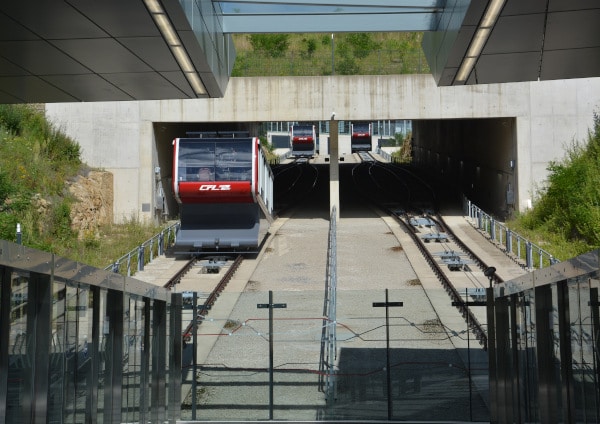
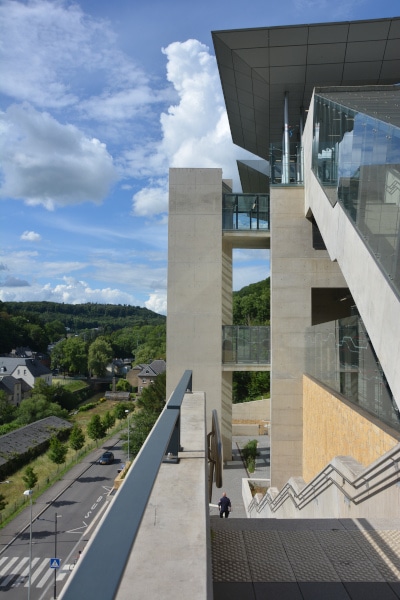
City-Center : shopping mile by day, pub scene in the evening
The City-Center is located on a neighbouring mountain plateau and is primarily a shopping mile. Or pub mile – depending on what time of day you arrive there. Both are very lively and popular, Luxembourgers are sociable and multinational. Almost 70% of the inhabitants have „a migration background“. This means that they are not original Luxembourgers. That French people make up the majority of the immigrants is relatively understandable – but the second, almost equally large group of immigrants comes from Portugal! Of course Belgians, Dutch and Germans also live in Luxembourg, and descendants of many other nations. Besides Luxembourgish, German is also officially spoken, but you can hear French on the streets, besides the colourful mixture of languages that results from the large number of immigrants.
Luxembourg – Historic fortress city
This diversity is not necessarily a phenomenon of modern times or even an „EU effect“! Luxembourg was a fortified city for centuries. Its strategically important position in the European centre ensured that Luxembourg was fortified at an early stage.
In 963, Count Siegfried acquired the Bock Rock located east of the city by an act of exchange and built a castle there. This allowed the most important access to the city and the river valleys of the Alzette to be controlled. By the end of the Middle Ages, the developing upper town and the settlements on the Alzette already had a population of about 5000. These are mainly servants of the count, craftsmen, farmers, gardeners, traders and innkeepers.

Exploring via fortress paths
Starting from a medieval city wall, a first bastion was built in the middle of the 16th century as a reaction to the beginning of cannon armament. The location on the mountain ridges and the deep river valleys favoured the defence. Especially the western side was strengthened. Spanish fortress engineers were called in for further expansion.
But in 1684 Luxembourg was conquered by the French and Louis XIV ordered the further extension – now by the French engineer Sebastien Le Prestre Vauban.
In 1687 the fortress of Luxembourg was part of the negotiations for the peace treaty of Ryswick and the Spanish line of the Habsburgs. In the Spanish Wars of Success it then came under Austro-Dutch rule and was massively expanded from 1715 onwards. Under the direction of the engineer Simon de Beauffe, a third outer ring of defence was built, which made the fortress the strongest in Central Europe. When Luxembourg fell into French hands again in 1795, the paraphrase „Gibraltar of the North“ was created as a comparison.
Also after the Congress of Vienna in the 19th century, the fortress was further extended, this time by Prussian engineers between 1815 and 1866.
Neutral and disarmed since the middle of the 19th century
The Treaty of London of 11 May 1867 declared Luxembourg a neutral state. A condition for this is the „de-fortification“ – the fortifications are „dragged“. That means they are dismantled until they have lost their military functionality. The work on this takes until 1883, i.e. 16 years. On the remains of the fortress, the present city of Luxembourg was built. You can visit the still preserved parts of the fortress. Several „fortress paths“ lead you over the ruins and through the catacombs.
Visit to the Grand Duke
During the construction of the roads from the east over the Bock – Rock, further underground parts of the original fortress were discovered. Therefore the road was raised and forms a protective roof for the crypt, which can be visited. Externally, the „hollow tooth“ is the most striking feature, the remains of a last tower next to the road. Visitor paths to the right and left of the road allow you to see other parts of the castle and get beautiful views of the upper town and the „Grund“ on the banks of the Alzette.
Luxembourg is formally still a Grand Duchy. When visiting the upper town, a visit to the Grand Ducal Palace is a must. An impressive building with turrets, bay windows and a balcony. During the day, the palace guard sets up in front of the palace and patrols on a well-trodden path in front of the building.

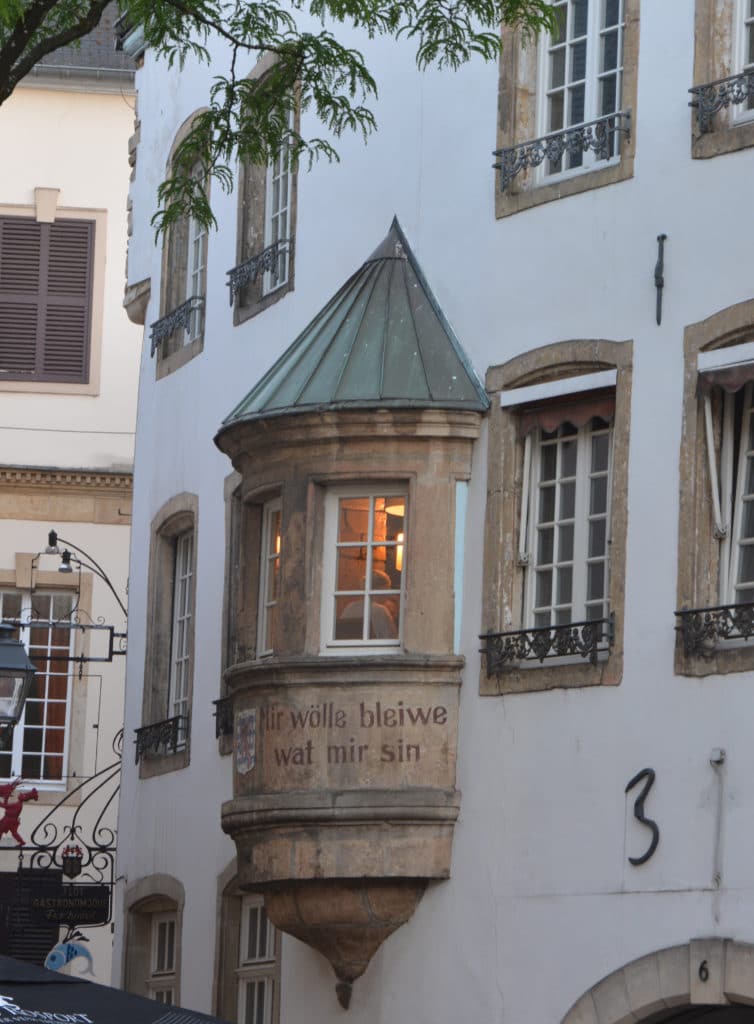
Art and culture in Luxembourg
If you want to round off your visit to Luxembourg with art and culture, the city offers great opportunities.
For music lovers, the Philharmonie on the Kirchberg is the first port of call. The modern building has been celebrating world-class music for 15 years.
Only a few metres further on, art lovers will get their money’s worth in the Mudam – Musée d’Art Moderne Grand-Duc Jean. From photography to installations, vernissages and discussion events, this house offers space for a wide variety of artistic forms of expression. Programmes for children and young people introduce young people to modern art.
The Luxembourg Theatre is already a little older in architectural terms – planned and built in the 1960s with international participation by Parisian architects, it is still a venue with a lively programme – design.
Not far from the Grand Ducal Palace in the upper city you will find the Musee national d’historie et d’art – National Museum of History and Art. In the MNHA you will find impressive collections on 6200 square meters, such as the Roman mosaic of the „Villa von Vichten from 240 AD, Art – Deco – treasures from the house of the porcelain manufactory Villeroy and Boch or archaeological collections in rooms carved out of the rock.


Travel tips for Luxembourg – City
The Luxembourg weather
Arrival
Luxembourg by train
You can reach Luxembourg very easily by train*. You only need tickets to the border stations in Luxembourg – because in the country of Luxembourg, 2nd class travel is free. The same applies to the entire public transport system – including the city buses and the new tram in Luxembourg City. You can buy a day ticket for the first class on the train for 6 € at the ticket machines.
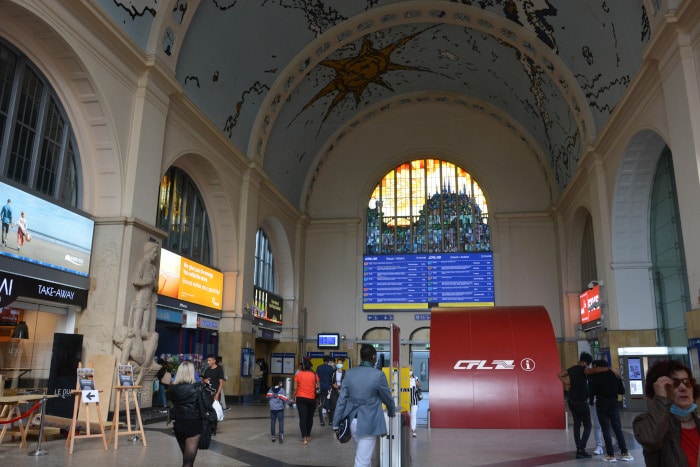
If you were perhaps on the Vennbahn cycle path before, you can easily travel from the north of Luxembourg, Troisvierges, by regional express train to Luxembourg City in about 1 hour and get a taste of „city air“ for a few days. Or you can use the city as a starting point for further explorations of Luxembourg. Within max. one hour you can reach every other starting point for landscape tours on all railway lines free of charge.
Arrival with own car or rental car
With your own car or a rental car*, you can reach Luxembourg very easily thanks to its central location in Western Europe. Several motorways lead into the country. From Germany this is mainly the A1 motorway via Trier or the A8 from Saarbrücken. Petrol is very cheap, as hardly any taxes are levied. But since the city of Luxembourg is spread over mountain plateaus and narrow valleys, it makes sense to park your car in a commuter parking lot outside the city and use the train to get to the city.
Luxembourg via airport
Luxembourg City has an airport that is integrated into the international flight network.
Accommodation in Luxembourg City – Hotels and a Youth hostel
The Hotel Francais* is very popular, which is mainly due to its location directly in the centre. Only a few hundred metres separate you from the Grand Ducal Palace, the Place de la Constitution and the Cathedral Notre Dame… Cosy rooms as well as a French restaurant offer you pleasant hours in the Luxembourg capital. And other pubs nearby are only a few steps away… For business meetings, conference rooms and communication equipment are available. Outside activities can be supported with packed lunches.
The new Hotel Simoncini* is also close to the city centre and of particular interest to guests with an artistic bent. The hotel is very disabled-friendly. Bright, spacious rooms make the stay pleasant. You can visit the upper town on foot, for more distant destinations the bus stop is only a few metres away and the new tram will further expand the local transport system. Pets are allowed.
Further from the centre, but closer to the EU institutions on the Kirchberg, you will find the Hotel Melia Luxembourg*. Very convenient for art lovers and music lovers, as the „Mudam“ and the Philharmonie are just ‚around the corner‘. You can use the free bus service to get to the city centre, a bus stop is located in front of the hotel. For relaxation and recreation there is a spa area with sauna and fitness center. The hotel is also well equipped for cyclists, with covered and secure bike storage, extra drying rooms for equipment, repair facilities and a wealth of information for cyclists in Luxembourg.
The Novhotel Luxembourg Kirchberg* is also located on the Kirchberg and thus close to the Philharmonie and Mudam. Family rooms are available. Children’s menus are offered in the restaurant. There is an indoor play area. Fitness equipment is also available here. Pets are allowed.
Luxembourg – best of Hotels
The Sofitel Luxembourg***** Le Grand Ducal* is a truly grand ducal setting. The hotel includes a bar, restaurant and fitness centre. This includes the gourmet cuisine of Sebastien Pierrot. From the hotel, you have the best view over the city as well as the river valleys of the Alzette and the Petrusse. For business travellers, both the connection with the new TGV station and the location near embassies and important companies are interesting.
Luxurious in art-deco style and as close as possible to Luxembourg’s upper city, the Hotel***** Le Place de Armes* awaits you. All rooms have their individual charm, historical architectural elements such as beams, old doors, fireplaces and stairs have been incorporated into the house and room design. The cuisine also offers world-class dishes. Family rooms are available. A fitness area is also available.
You can spend the night in royal-sized rooms at Hotel***** Le Royal*, a few hundred metres from the Luxembourg Grand Ducal Palace. Particularly worth mentioning is the extended wellness and fitness area with sauna and hamam, beauty salon and massage offers. In addition, there is the new piano bar with enchanting fruit cocktails. If you want to strengthen your fitness outside the hotel, you can use the hotel’s bicycle rental service.
budget accommodation in Luxembourg City – Youth hostel in Pfaffenthal
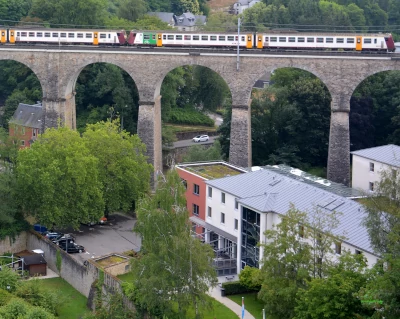
By far the cheapest accommodation is the Luxembourg City Youth Hostel* below the „hollow tooth“, i.e. the Bock rock and next to the railroad viaduct. In the hostel is a variety of clean multi-bed rooms with double bunk beds and shower bath available. Breakfast (incl.) and other meals are available in the in-house restaurant with a large terrace. From lunchtime onwards, the hostel’s restaurant can also be used by guests who are not staying at the hostel. This is still a relatively inexpensive opportunity for a good day or evening meal in Luxembourg City. The city center on the mountain and the Grund quartier are within walking distance from the hostel, and there are also stops for the free city buses nearby. The nearest train station is Pfaffenthal – Kirchberg, which is also doable on foot. A youth hostel – card is not required for the Luxembourg Youth Hostel.
Did you like it? Then share the link!
If you liked the post and maybe want to invite your friends to the Luxembourg – Tour, just share the link to the post in your social media channels! A positive echo in the net world strengthens the worth reading pages in the search results 🙂
Reference to * advertising – Links
Some of the links in this article are marked with *. These are so-called affiliate links. If you click on them, you will reach an online provider for the respective topic. If you book there, the sonnige pfade blog will receive a small commission for operating this website. Nothing will be more expensive for you, because the commission is already included in the pricing.
